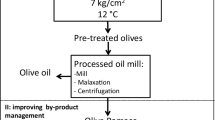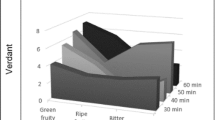Abstract
New generation decanters allow operators to make real-time adjustments during the virgin olive oil extraction process in order to gain the best performance possible. However, the opportunity to act in line requires a deep understanding of the consequences of changing machine parameters. To this purpose, an experiment was carried out at industrial scale. The decanter feed rate (Fr), ranging from 4075 to 5820 kg h−1, the bowl/screw conveyor differential speed (∆n), set at 18 and 22, and two ripening degrees of the olives were considered as process variables. Two combinations Fr-∆n, namely 4620 kg h−1 at ∆n-18 and 5210 kg h−1 at ∆n-22, were found to similarly maximize the process efficiency, regardless the raw material features. After pointing out the best working settings, the corresponding virgin olive oils were compared. The analysis of variance showed that peroxide value, K 232, K 270, phenols, chlorophylls, β-tocopherol, fruity and bitter notes, and C6 volatile compounds were significantly affected by the machine parameters. An inverse proportionality was observed between the combination Fr-∆n and the phenolic compounds. On the whole, the sampling factor exerted a larger influence on the product quality than the decanter set-up.


Similar content being viewed by others
References
Abenoza, M., Benito, M., Saldaña, G., Álvarez, I., Raso, J., & Sánchez-Gimeno, A. C. (2013). Effects of pulsed electric field on yield extraction and quality of olive oil. Food and Bioprocess Technology, 6, 1367–1373.
Altieri, G. (2010). Comparative trials and an empirical model to assess throughput indices in olive oil extraction by decanter centrifuge. Journal of Food Engineering, 97, 46–56.
Altieri, G., Di Renzo, G. C., & Genovese, F. (2013). Horizontal centrifuge with screw conveyor (decanter): optimization of oil/water levels and differential speed during olive oil extraction. Journal of Food Engineering, 119, 561–572.
Amirante, P., Clodoveo, M. L., Leone, A., Tamborrino, A., & Patel, V. B. (2010). Influence of different centrifugal extraction systems on antioxidant content and stability of virgin olive oil. In V. R. Preedy & R. R. Watson (Eds.), Olives and olive oil in health and disease prevention (pp. 85–93). London: Academic Press.
Angerosa, F., Servili, M., Selvaggini, R., Taticchi, A., Esposto, S., & Montedoro, G. F. (2004). Volatile compounds in virgin olive oil: occurrence and their relationship with the quality. Journal of Chromatography A, 1054, 17–31.
Artajo, L. S., Romero, M. P., & Motilva, M. J. (2006). Transfer of phenolic compounds during olive oil extraction in relation of ripening stage of the fruit. Journal of the Science of Food and Agriculture, 86, 518–527.
Baccouri, O., Guerfel, M., Baccouri, B., Cerretani, L., Bendini, A., Lercker, G., Zarrouk, M., & Miled, D. D. B. (2008). Chemical composition and oxidative stability of Tunisian monovarietal virgin olive oils with regard to fruit ripening. Food Chemistry, 109, 743–754.
Bejaoui, M. A., Beltran, G., Aguilera, M. P., & Jimenez, A. (2016). Continuous conditioning of olive paste by high power ultrasounds: response surface methodology to predict temperature and its effect on oil yield and virgin olive oil characteristics. LWT - Food Science and Technology, 69, 175–184.
Beltrán, G., Aguilera, M. P., Del Rio, C., Sanchez, S., & Martinez, L. (2005). Influence of fruit ripening process on the natural antioxidant content of Hojiblanca virgin olive oils. Food Chemistry, 89, 207–215.
Bendini, A., Cerretani, L., Carrasco-Pancorbo, A., Gómez-Caravaca, A. M., Segura-Carretero, A., Fernández-Gutiérrez, A., & Lercker, G. (2007). Phenolic molecules in virgin olive oils: a survey of their sensory properties, health effects, antioxidant activity and analytical methods. An overview of the last decade. Molecules, 12, 1679–1719.
Caponio, F., Summo, C., Paradiso, V. M., & Pasqualone, A. (2014a). Influence of decanter working parameters on the extra virgin olive oil quality. European Journal of Lipid Science and Technology, 116, 1626–1633.
Caponio, F., Monteleone, I. J., Martellini, G., Summo, C., Paradiso, V. M., & Pasqualone, A. (2014b). Effect of talc addition on the extraction yield and quality of extra virgin olive oils from Coratina cultivar after production and during storage. Journal of Oleo Science, 63, 1125–1132.
Caponio, F., Durante, V., Varva, G., Silletti, R., Previtali, M. A., Viggiani, I., Squeo, G., Summo, C., Pasqualone, A., Gomes, T., & Baiano, A. (2016). Effect of infusion of spices into the oil vs. combined malaxation of olive paste and spices on quality of naturally flavoured virgin olive oils. Food Chemistry, 202, 211–228.
Catalano, P., Pipitone, F., Calafatello, A., & Leone, A. (2003). Productive efficiency of decanters with short and variable dynamic pressure cones. Biosystems Engineering, 86, 459–464.
Di Giovacchino, L., Sestili, S., & Di Vincenzo, D. (2002). Influence of olive processing on virgin olive oil quality. European Journal of Lipid Science and Technology, 104, 587–601.
García, J. M., Seller, S., & Pérez-Camino, M. C. (1996). Influence of fruit ripening on olive oil quality. Journal of Agriculture and Food Chemistry, 44, 3516–3520.
IUPAC (1995). Determination of chlorophyll pigments in crude vegetable oils. Pure and Applied Chemistry, 67, 1781–1787.
Jiménez, A., Rodríguez, R., Fernández-Caro, I., Guillén, R., Fernández-Bolãnos, J., & Heredia, A. (2001). Olive fruit cell wall: degradation of pectic polysaccharides during ripening. Journal of Agriculture and Food Chemistry, 49, 409–415.
Jiménez, B., Sánchez-Ortiz, A., Lorenzo, M. L., & Rivas, A. (2013). Influence of fruit ripening on agronomic parameters, quality indices, sensory attributes and phenolic compounds of Picudo olive oils. Food Research International, 54, 1860–1867.
Kalua, C. M., Allen, M. S., Bedgood Jr., D. R., Bishop, A. G., Prenzler, P. D., & Robards, K. (2007). Olive oil volatile compounds, flavour development and quality: a critical review. Food Chemistry, 100, 273–286.
Leone, A., Tamborrino, A., Romaniello, R., Zagaria, R., & Sabella, E. (2014a). Specification and implementation of a continuous microwave-assisted system for paste malaxation in an olive oil extraction plant. Biosystems Engineering, 125, 24–35.
Leone, A., Tamborrino, A., Zagaria, R., Sabella, E., & Romaniello, R. (2014b). Plant innovation in the olive oil extraction process: a comparison of efficiency and energy consumption between microwave treatment and traditional malaxation of olive pastes. Journal of Food Engineering, 146, 44–52.
Leone, A., Romaniello, R., Zagaria, R., & Tamborrino, A. (2015). Mathematical modelling of the performance parameters of a new decanter centrifuge generation. Journal of Food Engineering, 166, 10–20.
Letki, A. G. (2007). Centrifugation | decanters. In I. D. Wilson (Ed.), Encyclopedia of separation science (pp. 1–10). Oxford: Academic Press ISBN 9780122267703.
Mafra, I., Lanza, B., Reis, A., Marsilio, V., Campestre, C., De Angelis, M., & Coimbra, M. A. (2001). Effect of ripening on texture, microstructure and cell wall polysaccharide composition of olive fruit (Olea europaea). Physiologia Plantarum, 111, 439–447.
Mìnguez-Mosquera, I., Gallardo-Guerrero, L., & Roca, M. (2002). Pectinesterase and polygalacturonase in changes of pectic matter in olives (cv. Hojiblanca) intended for milling. Journal of the American Oil Chemists Society, 79, 93–99.
Official Journal of the European Communities (1991). European Community Regulation No. 2568/1991, N. L. 248 of September 5th, Publications Office of the European Union, Bruxelles.
Official Journal of the European Communities (2002). Commission Regulation No. 796/2002, N. L. 128 of May 15th, Publications Office of the European Union, Bruxelles.
Roca, M., & Minguez-Mosquera, M. I. (2001). Change in the natural ratio between chlorophylls and carotenoids in olive fruit during processing for virgin olive oil. Journal of the American Oil Chemists Society, 78, 133–138.
Salvador, M. D., Aranda, F., & Fregapane, G. (2001). Influence of fruit ripening on Cornicabra virgin olive oil quality. A study of four successive crop seasons. Food Chemistry, 73, 45–53.
Servili, M., Selvaggini, R., Esposto, S., Taticchi, A., Montedoro, G., & Morozzi, G. (2004). Health and sensory properties of virgin olive oil hydrophilic phenols: agronomic and technological aspects of production that affect their occurrence in the oil. Journal of Chromatography A, 1054, 113–127.
Squeo, G., Silletti, R., Summo, C., Paradiso, V. M., Pasqualone, A., & Caponio, F. (2016). Influence of calcium carbonate on extraction yield and quality of extra virgin oil from olive (Olea europaea L. cv. Coratina). Food Chemistry, 209, 65–71.
Tamborrino, A., Catalano, P., & Leone, A. (2014). Using an in-line rotating torque transducer to study the rheological aspects of malaxed olive paste. Journal of Food Engineering, 126, 65–71.
Tamborrino, A., Leone, A., Romaniello, R., Catalano, P., & Bianchi, B. (2015). Comparative experiments to assess the performance of an innovative horizontal centrifuge working in a continuous olive oil plant. Biosystems Engineering, 129, 160–168.
Toschi, T. G., Berardinelli, A., Cevoli, C., Iaccheri, E., Di Lecce, G., Bendini, A., & Ragni, L. (2013). Effectiveness of the mechanical excitation applied to the olive paste: possible improving of the oil yield, in malaxation phase, by vibration systems. Journal of Agricultural Engineering, 44, 166–169.
Valipour, M. (2015a). Future of agricultural water management in Africa. Archives of Agronomy and Soil Science, 61, 907–927.
Valipour, M. (2015b). Land use policy and agricultural water management of the previous half of century in Africa. Applied Water Science, 5, 367–395.
Valipour, M., Ziatabar Ahmadi, M., Raeini-Sarjaz, M., Gholami Sefidkouhi, M., Shahnazari, A., Fazlola, R., & Darzi-Naftchali, A. (2014). Agricultural water management in the world during past half century. Archives of Agronomy and Soil Science, 61, 657–678.
Vossen, P. (2007). Olive oil: history, production, and characteristics of the world’s classic oils. Hortscience, 42, 1093–1100.
Zamora, R., Alaiz, M., & Hidalgo, F. J. (2001). Influence of cultivar and fruit ripening on olive (Olea europaea) fruit protein content, composition, and antioxidant activity. Journal of Agricultural and Food Chemistry, 49, 4267–4270.
Acknowledgments
This work has been supported by AGER 2 Project, grant n° 2016-0105.
Author information
Authors and Affiliations
Corresponding author
Rights and permissions
About this article
Cite this article
Squeo, G., Tamborrino, A., Pasqualone, A. et al. Assessment of the Influence of the Decanter Set-up During Continuous Processing of Olives at Different Pigmentation Index. Food Bioprocess Technol 10, 592–602 (2017). https://doi.org/10.1007/s11947-016-1842-7
Received:
Accepted:
Published:
Issue Date:
DOI: https://doi.org/10.1007/s11947-016-1842-7




